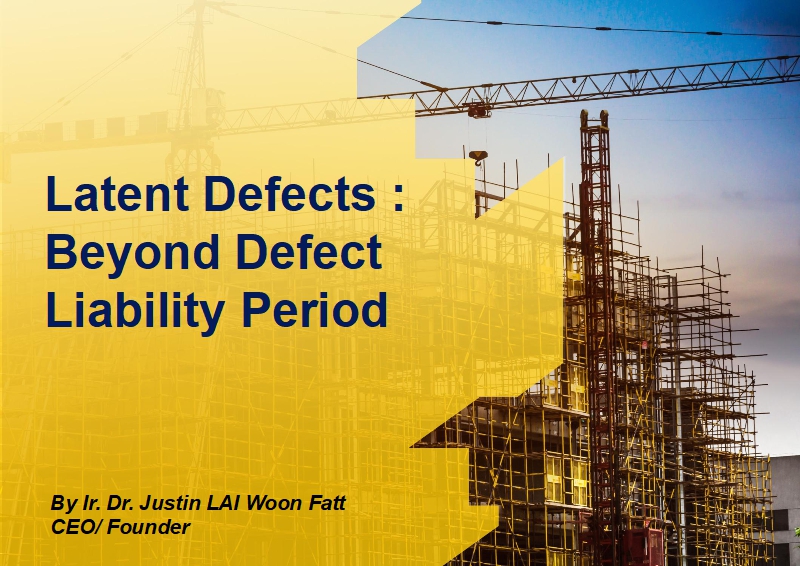Author: Ir. Dr. Justin LAI Woon Fatt | 28 March, 2021
WHAT ARE LATENT DEFECTS?
Latent defects are potential invisible faults that are not been identified through general inspection[1]. Those are defects and damages caused by improper design, poor workmanship, or construction material problem. Latent defects are opposite to apparent patent defects [2]. It could only be found after several years of occupancy or long after the defects liability period (DLP) has expired, even with good care.
The examples of typical latent defects are listed as follow:
a) Improper Design Problem:
- Inappropriate construction material was specified during the building design stage. For example, cementitious waterproofing system was specified at the rooftop where the area has direct exposure to extreme weather condition. Under such condition, the material would experience cyclical thermal contraction and expansion. However, cementitious waterproofing material is weak in withstanding the thermal movements due to the low elasticity. Thus, the waterproofing layer would fatigue and crack after the repeating process of thermal contraction and expansion. Subsequently, the waterproofing layer would fail to perform due to crack development.
- Improper sizing of the rainwater downpipe could also lead to water leakage on the rooftop. The undersized rainwater downpipe allowed a limited volume of the rainwater to be discharged from rooftop. The high volume of rainwater during heavy rainfall would create the gutter overflowing and cause water leakage problem.
b) Poor Workmanship Problem:
- Poor foundation bearing strength which due to the unsatisfactory workmanship could lead to building settlement and subsequently cause the building cracks. Contractor shall ensure proper workmanship during the piling process. All piling shall be driven to set or bedrock to ensure stability, unless the piles were designed as friction piles.
- Unprofessional tile installation always leads to tile pop-up due to the hollowness exists in the binder mortar layer. The defects could be caused by improper application or not applying the bonding agents between the mortar layer of the tiles and floor.
c) Construction Material Problem:
- Construction material problems could be caused by incorrect manufacturers’ declaration or improper contractors’ “cost-saving” exercises. Substandard materials were supplied to fulfil their obligation with the lowest possible costs. For example, tiles were found cracked over time after they have been laid. After inspection, it was proved that the problem was not caused by workmanship problem, as there was no existence of hollowness. Therefore, this is mainly due to the poor quality of the tiles.
- The concrete slab was found cracked after the building has been long occupied. It is suspected due to overloading or the substandard of concrete was supplied. After conducting the concrete core test, it was proven that the casted concrete has not achieved the minimum required strength and thus causing it to crack over time.
About 60% of the latent defects can be avoided with a good design and decision[3]. Aside from abiding to the design codes and standards, the designer must be aware of the design’s shortcomings such as the design suitability, material resistance to on-site weather conditions, design specifications, design details, etc. Besides good design and decision, latent defects may be avoided by proper workmanship and maintenance of buildings.
THE LIMITATION ACT (ACT 254)
The property owner will no longer have a statutory right to request the developer rectify any building damages detected after the DLP. Thus, the property owner needs to know their rights defined in the Limitation Act.
Section 6(1)(a) of the Limitation Act 1953 says that “actions shall not be brought after the expiration of six years from the date on which the cause of action accrued[4].” This limitation clause protects the property owner six years from the date of latent damages occurrence (not involving personal injuries) after the purchase. However, this was unfair to the owner who suffers from latent defects that bring up after six years of expiration because they could not commence any action in tort.

Figure 1: Sample Case Under Act 254
THE LIMITATION (AMENDMENT) ACT 2018 (ACT A1566)
The Limitation (Amendment) Act 2018 is an amendment to the Limitation Act 1953 that redresses the injustice which comes into force on 1 September 2019, especially in the case involving latent defects. Section 6A has been introduced after Section 6 in the principal Act (ACT 254). Section 6A allows an extension of three years from the date of latent defects discovery to initiate the action. It only applies if the following conditions are met[1][5][6]:
- The action is commenced after the 6 years limitation from the date of latent damages occurrence;
- The claim is for defects not involving personal injuries;
- The action shall not be brought after the 15 years limitation from the date of latent damages occurrence (Section 24A).
 Figure 2: Sample Case Under The (Amendment) Act 2018 (Act A1566)
Figure 2: Sample Case Under The (Amendment) Act 2018 (Act A1566)
The Limitation (Amendment) Act 2018 is equivalent to similar laws in the United Kingdom and Singapore [5]. In addition, the explanatory statement in the Bill[1] states that “The proposed new Section 6A considers negligence cases involving latent damage in construction cases…”. It seems that the Parliament plans to extend Section 6A only apply to latent defects in the building. Table 1 concludes the amendment for the Limitation Act.
Table 1: The Amendment For The Limitation Act
CONCLUSION
If latent defects are found after the DLP and are believed to have been caused by the negligence of the developer, the property owner shall contact a lawyer for further clarification and the appropriate actions. The owner shall also engage a professional engineer to inspect the defects and prepare an engineering report.
Ir. Dr. Justin LAI Woon Fatt
CEO/ Founder
IPM Group
References:
[1] Parliament of Malaysia (2018). An Act to amend the Limitation Act 1953. Bill. (PN(U2)2718). Retrieved on 5th March 2021 from https://www.cljlaw.com/files/bills/pdf/2018/MY_FS_BIL_2018_04.pdf
[2] Designing Buildings Wiki (2021). Latent Defects. Retrieved on 5th March 2021 from https://www.designingbuildings.co.uk/wiki/Latent_defects
[3] Wai-Kiong Chong, and Sio-Pheng Low (2006). Latent Building Defects: Causes and Design Strategies to Prevent Them. Retrieved on 5th March 2021 from https://www.fep.up.pt/disciplinas/PGI914/Ref_topico1/LatentBuilding%20Defects.pdf
[4] The Commissioner Of Law Revision (2006). Laws Of Malaysia. Act 254, Limitation Act 1953. Retrieved on 5th March 2021 from http://www.agc.gov.my/agcportal/uploads/files/Publications/LOM/EN/Act%20254.pdf
[5] Baker McKenzie (2019). Malaysia: Limitation Period for Latent Defects/Latent Damages. Retrieved on 5th March 2021 from https://www.bakermckenzie.com/en/insight/publications/2019/08/limitation-period-for-latent-defects
[6] The Commissioner Of Law Revision (2006). Laws Of Malaysia. Act 1566, Limitation (Amendment) Act 2018. Retrieved on 5th March 2021 from https://www.zulrafique.com.my/ckfinder/userfiles/files/legislation%20update/Act%20A1566%20-%20Limitation%20(Amendment)%20Act%202018%20(01777415xA335E).pdf

